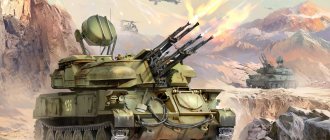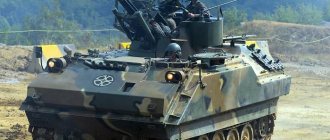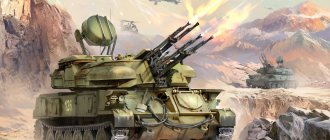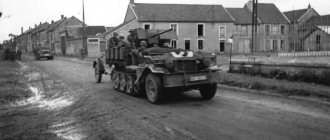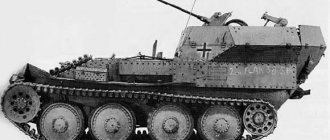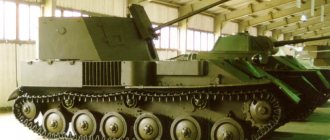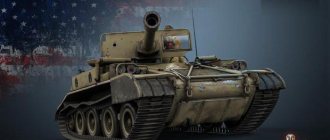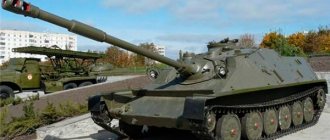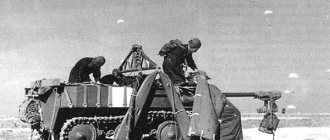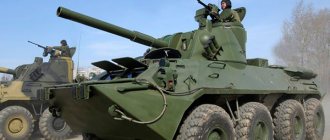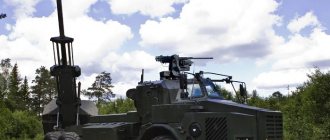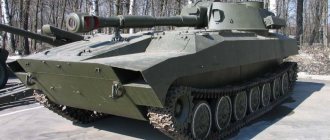Anti-aircraft self-propelled gun ZSU-37-2 "Yenisei"
37 mm ZSU-37-2 “Yenisei”
On April 17, 1957, almost simultaneously with the start of serial production of the ZSU-57-2, the Council of Ministers of the USSR adopted Resolution No. 426-211 on the development of new rapid-fire ZSU “Shilka” and “Yenisei” with radar guidance systems. This was a kind of response to the adoption of the M42A1 ZSU into service in the United States. Formally, “Shilka” and “Yenisei” were not competitors, since the first was developed to provide air defense for motorized rifle regiments to hit targets at altitudes up to 1500 m, and the second was for air defense of tank regiments and divisions and operated at altitudes up to 3000 m. In an anti-aircraft self-propelled The ZSU-37-2 “Yenisei” installation used a 37-mm 500P assault rifle, developed at OKB-16 (chief designer A.E. Nudelman). The 500P had no analogues in ballistics, and its cartridges were not interchangeable with other 37-mm automatic guns of the army and navy, with the exception of the low-volume Shkval anti-aircraft gun. Especially for the Yenisei, OKB-43 designed a twin Angara cannon, equipped with two 500P machine guns with belt feed. “Angara” had a liquid cooling system for the barrels and servo electro-hydraulic drives, which were later planned to be replaced with purely electric ones. Guidance drive systems were developed by the Moscow TsNII-173 GKOT - for power servo guidance drives and the Kovrov branch of TsNII-173 (now VNII Signal) - for stabilizing the line of sight and line of fire. Guidance of the Angara was carried out using the noise-proof RPK Baikal, created at NII-20 GKRE and operating in the centimeter wavelength range - about 3 cm. But during the tests it turned out that neither the RPK Tobol on Shilka, nor Baikal on the “Yenisei” they could not independently search for an air target with sufficient efficiency, therefore, even in the resolution of SM No. 426-211 of April 17, 1957, it was provided for the creation and transfer for state tests in the second quarter of 1960 of the mobile radar “Ob” to control the ZSU . “Ob” included the “Neva” command vehicle with the “Irtysh” target designation radar and the “Baikal” RPK, located in the “Yenisei” ZSU. The Ob complex was supposed to simultaneously control the fire of six to eight ZSUs. However, in mid-1959, work on the Ob was stopped - this made it possible to speed up the development of the Krug anti-aircraft missile system. The chassis for the Yenisei was designed at the Uralmash Design Bureau under the leadership of G.S. Efimov based on the chassis of the experimental self-propelled unit SU-100P. Its production was supposed to be launched at the Lipetsk Tractor Plant.
The ZSU-37-2 had bulletproof armor, which, in the places where the ammunition was placed, provided protection from the 7.62-mm B-32 rifle armor-piercing bullet from a distance of 400 m. To power the on-board network, the Yenisei was equipped with a special gas turbine engine developed by NAMI, the use which made it possible to ensure rapid readiness for combat at low air temperatures. Tests of the Shilka and Yenisei self-propelled guns took place in parallel, although according to different programs. “Yenisei” had a range and ceiling range close to the ZSU-57-2, and, according to the conclusion of the State Commission, provided cover for tank forces in all types of combat, since air attack weapons against tank forces primarily operate at altitudes up to 3000 m Normal firing mode (tank) - continuous burst of up to 150 rounds per barrel, then a break of 30 seconds (air cooling) and repeating the cycle until the ammunition is used up. During the tests, it was found that one Yenisei ZSU is superior in efficiency to a six-gun battery of 57-mm S-60 cannons and a battery of four ZSU-57-2. During testing, the Yenisei ZSU ensured shooting while moving on virgin soil at a speed of 20-25 km/h. When driving along a tank track at a training ground at a speed of 8-10 km/h, the shooting accuracy was 25% lower than from a standstill. The firing accuracy of the Angara cannon is 2-2.5 times higher than that of the S-68 cannon. During state tests, 6,266 shots were fired from the Angara cannon. At the same time, only two delays and four breakdowns were noted, which amounted to 0.08% of delays and 0.06% of breakdowns from the number of shots fired, which is less than permissible according to the TTT. According to the data obtained during the tests, it was proposed to use the Yenisei to protect the army anti-aircraft missile systems Krug and Kub, since its effective firing zone overlapped the dead zone of these air defense systems. After completing the tests of “Shilka” and “Yenisei”, the state commission examined the comparative characteristics of both self-propelled guns and issued a conclusion on them: 1. “Shilka” and “Yenisei” are equipped with a radar system and provide shooting day and night in any weather; 2. the weight of the Yenisei is 28 tons, which is unacceptable for arming motorized rifle units and airborne forces; 3. when firing at MiG-17 and Il-28 aircraft at an altitude of 200 and 500 m, the Shilka is 2 and 1.5 times more effective than the Yenisei, respectively; 4. “Yenisei” is intended for air defense of tank regiments and tank divisions for the following reasons: – tank units and formations operate mainly in isolation from the main group of troops. “Yenisei” provides escort of tanks at all stages of the battle, provides effective fire at altitudes up to 3000 m and ranges up to 4500 m. The use of this installation practically eliminates accurate bombing of tanks, which “Shilka” cannot provide; – there are quite powerful high-explosive fragmentation and armor-piercing shells. “Yenisei” can conduct more effective self-defense shooting at ground targets when following tank forces in battle formations; 5. unification of new self-propelled guns with products that are in mass production: - according to “Shilka” - a 23-mm machine gun and rounds for it are in mass production. The SU-85 tracked base is manufactured at MMZ; - according to the Yenisei - the RPK is unified in modules with the Krug system, in the tracked base - with the SU-100P, for the production of which 2-3 factories are preparing.
Both in the above excerpts from the commission’s conclusion and in other documents there is no clear justification for the priority of “Shilka” in comparison with “Yenisei”. Even their cost was comparable. The commission recommended adopting both ZSUs. But by resolution of the Council of Ministers of the USSR dated September 5, 1962 No. 925-401, only the Shilka was accepted into service, and on September 20 of the same year, the State Defense Committee issued an order to stop work on the Yenisei. An indirect proof of the delicacy of the situation was that two days after the closure of work on the Yenisei, an order from the State Committee for Technical Development appeared on equal bonuses for organizations working on both machines.
Characteristics:
Combat weight, t – 27.5 Crew, people. – 4 Overall dimensions, mm: length with forward guns – 6460 hull length – 6460 width – 3100 Bulletproof armor Armament – 2x37 mm 500P guns (Angara artillery system) Ammunition – 2900 rounds Firing range at air targets, m – 4500 Engine B -54-105, power – 294 kW Specific ground pressure, MPa – 0.061 Maximum speed on the highway, km/h – 60 Cruising range on the highway, km – 450 Obstacles to be overcome: ford depth, m – 1.0
Description of design
The ZSU-57-2 had a layout with the engine and transmission compartment located in the rear of the hull, and the weapons in a rotating turret. The ZSU crew consisted of six people: a driver, located in the frontal part of the hull on the left; gunner, gunner-sight installer, two loaders (right and left guns) and installation commander, who were in the turret.
Armament
Fire control system (detailed view)
The self-propelled gun was armed with a twin 57-mm automatic gun S-68
, consisting of two S-60 cannons with a barrel length of 76.6 calibers / 4365 mm, distinguished by a mirror arrangement of mechanisms. The S-60 automatic system worked by using recoil energy with a short barrel stroke. The gun had a monoblock barrel, a piston sliding bolt, a hydraulic recoil brake, a spring knurl and was equipped with a muzzle brake.
The twin installation of guns connected by cradles into a single block was placed on trunnions on the floor of the turret. Vertical, within the range of −5...+85°, and horizontal guidance were carried out using electro-hydraulic drives, powered by a constant-speed electric motor through a hydraulic speed controller. The horizontal guidance speed was 30°, vertical guidance - 20° per second. In the event of an electric drive failure, the possibility of manual aiming remained: the vehicle commander was responsible for horizontal guidance, and the gunner was responsible for vertical guidance. The gun had a clip feed from box magazines for 4 shots, the practical rate of fire was 100-120 rounds per minute per barrel, but the maximum duration of continuous firing was 40-50 shots, after which the barrel had to be cooled. The ammunition load of the ZSU-57-2 was 300 unitary rounds, of which 176 in 44 magazines were placed in stowage in the turret, 72 in 18 magazines were located in the bow of the hull, and another 52 rounds not loaded into clips were placed under the turret floor.
| Ammunition for the 57 mm S-68 cannon | |||||
| Projectile type | Brand | Shot weight, kg | Projectile weight, kg | Explosive mass, g | Muzzle velocity, m/s |
| fragmentation tracer grenade | OR-281U | 6,6 | 2,8 | 153 | 1000 |
| fragmentation tracer grenade | OR-281 | 6,6 | 2,8 | 153 | 1000 |
| armor-piercing tracer | BR-281U | 6,6 | 2,8 | 13 | 1000 |
| armor-piercing tracer | BR-281 | 6,6 | 2,8 | 13 | 1000 |
| armor-piercing solid tracer | BR-281SP | 6,6 | 2,8 | — | 1000 |
| Penetration table for C-68 | ||||
| Projectile \ Distance, m | 500 | 1000 | 1500 | 2000 |
| BR-281 / BR-281U (meeting angle 30°) | 90 | 80 | 70 | 60 |
| BR-281 / BR-281U (meeting angle 0°) | 110 | 100 | 85 | 70 |
| Data on the Soviet method of measuring armor penetration. It should be borne in mind that at different times and in different countries different methods for determining armor penetration were used. As a consequence, direct comparison with similar data from other weapons is often impossible or incorrect. |
Guidance accuracy on the ground and in the air
The company is also carrying out a number of works on the creation of drives and weapon stabilizers for land and aviation equipment. In particular, an electric drive for aiming weapons horizontally and vertically has been developed, which can be integrated into the newest T-14 Armata tank.
“We worked with Uralvagonzavod [part of Rostec] on a version of an electric vertical based on a mechanical lift: we made two prototypes that went through a full cycle of tests on the T-72 tank. We are ready to offer our developments in the event of the next modernization of the Armata,” Nikolaev said, noting that the new weapons drive can also be installed on previously developed tanks, in particular the T-72 and T-80.
The company also produces drives for the guns of the Ka-52 Alligator reconnaissance and attack helicopters.
According to the specialist, new gun drives for the Ka-52 will be in wide demand: these devices can be installed both on new helicopters and on vehicles undergoing repairs and modernization. They managed to significantly reduce the number of failures and improved the accuracy of burst fire.
Signal also produces drives for ground artillery systems. The head of the research and production complex No. 1 of the enterprise, Alexei Babkin, told TASS that the institute is a developer of guidance drives for the Smerch multiple launch rocket systems (MLRS) and modernized self-propelled artillery systems of the Msta-S family.
For the Smerch, the company has developed improved drives with a weapon guidance speed increased several times. “We are currently at the stage of manufacturing two samples and should conduct preliminary tests of the devices this year. Next year state tests will take place, then serial production is possible,” Babkin said.
According to him, the drives developed and produced by the institute are being integrated into the latest land equipment currently being created by JSC NPO Splav named after. A.N. Ganichev", including heavy flamethrower systems TOS-2 "Tosochka" and remote mining systems ISDM "Agriculture".
Story
Due to the loss, for various reasons, in the initial period of the Great Patriotic War of a large number of ZSUs based on the GAZ-AA (“lorry”), 29K and others, the leadership of the Armed Forces of the USSR understood the importance of the ZSU for protecting Red Army formations from enemy aircraft on the move and in battle, allowed the defense industry to conduct experiments with the installation of various air defense systems (machine guns and cannons), for example ZIS-43, SU-11, on the chassis of cars and tanks. In November 1943, the GBTU and the GAU of the Red Army were given the task to design and create a ZSU based on light tanks, to effectively suppress enemy aviation, by the design bureau (KB) of factories No. 38 and No. 40
Another source indicates the design bureau of plant No. 4 (Mytishchensky Machine-Building Plant) and specialists from the design bureau of plant No. 1 (Gorky Automobile Plant).
Combat vehicles (BM) of this brand have been mass-produced at the Mytishchi Machine-Building and Gorky Automobile Plants since 1945. Before the end of the Great Patriotic War, 12 anti-aircraft self-propelled guns were built at Plant No. 40 (4 units each in February, March and April). The basis for the ZSU-37 was the light anti-tank self-propelled gun SU-76M. Production of the ZSU-37 continued in the post-war period, even after the base SU-76M was discontinued. In the second half of 1945, another 58 anti-aircraft guns were produced. In 1946 - 30.
The ZSU-37 was the first production Soviet armored self-propelled anti-aircraft gun on a tracked chassis, ideal for protecting mobile units from air attacks. The main weapon of the combat vehicle was a 37-mm 61-K anti-aircraft gun mounted in a turret with circular rotation. The anti-aircraft self-propelled gun was also equipped with a range finder and radio station 10RK-12M (10RT-3).
The crew (crew) of the BM consisted of six people (commander, driver, rangefinder-azimuth gunner, rangefinder-gunner in elevation, loader, gunner-radio operator).
Operators
ZSU-57-2 operators
Modern
- Algeria - from 20 to 45 ZSU-57-2, as of 2016
- Egypt - 40 ZSU-57-2, as of 2016
- Iran - 80 ZSU-57-2, as of 2016
- DPRK - up to 250 ZSU-57-2 units, as of 2016
- Cuba - a number of ZSU-57-2, as of 2016
- Mozambique - 20 ZSU-57-2, as of 2016
- Nicaragua - up to 10 ZSU-57-2, as of 2016
- Syria - a number of ZSU-57, as of 2016
Former
- USSR - passed to the states formed after the collapse
- Angola - 40 ZSU-57-2 delivered from the USSR between 1975 and 1976, withdrawn from service
- Bosnia and Herzegovina - 6 ZSU-57-2, as of 2010
- Hungary - 40 ZSU-57-2 delivered from the USSR in 1966, withdrawn from service
- Vietnam - 100 ZSU-57-2 delivered from the USSR between 1971 and 1973, current status unclear
- GDR - 129 ZSU-57-2 delivered from the USSR between 1957 and 1961
- Iraq - 100 ZSU-57-2 delivered from the USSR between 1971 and 1973
- Poland - 129 ZSU-57-2 delivered from the USSR between 1957 and 1961, withdrawn from service
- Russia - a number of ZSU-57-2, as of 2010
- Romania - 60 ZSU-57-2 delivered from the USSR between 1965 and 1966
- Serbia - some, as of 2007
- Syria - 250 ZSU-57-2 delivered from the USSR between 1967 and 1973 - withdrawn from service
- Ukraine - 30 ZSU-57-2 as of June 2015 [ source not specified 1791 days
] - Finland - 12 ZSU-57-2 delivered from the USSR between 1960 and 1961, used under the designation LyPsv SU-57, withdrawn from service
- Ethiopia - 10 ZSU-57-2 delivered from the USSR in 1978
- Yugoslavia - 100 ZSU-57-2 delivered from the USSR between 1960 and 1961
History of creation
Soviet tank units and mechanized corps suffered significant losses from German attack aircraft - this was especially evident during the Battle of Kursk, when German aviation literally terrorized our armored vehicles. Therefore, on November 22, 1943, the GAU RKKA, in agreement with the GBTU RKKA, issued an order to plant No. 38 for the development anti-aircraft self-propelled gun, armed with a 37-mm anti-aircraft gun on a chassis of the same type as the SU-76 chassis. It must be recognized that the preliminary design, as well as the necessary calculations performed under the guidance of M.N. Shchukin, by this time they were already completed and only needed to make some improvements, which began in December 1943.
Anti-aircraft self-propelled gun ZSU-37. Blueprints. Click on the picture to enlarge.
In February 1944, the manufactured prototype of the SU-17 anti-aircraft self-propelled gun passed factory tests, which revealed a number of minor defects. The vehicle was recommended for adoption, taking into account the necessary modifications to its design. However, the plant’s capacity did not allow for the production of these self-propelled guns in parallel with the SU-76, and its technical re-equipment was not planned in the coming year. In addition, M.N. Shchukin took the place of chief designer of the restored Kharkov plant No. 75 (former Kharkov plant No. 183), where he moved in the fall. Therefore, all design and technological documentation for the vehicle was transferred to plant No. 40 in Mytishchi, which also produced the SU-76 and whose design bureau took the initiative to simplify the design of a self-propelled anti-aircraft gun in order to increase specific output and reduce the purchase price.
Anti-aircraft self-propelled gun ZSU-37. Blueprints. Click on the picture to enlarge.
In April 1944, a new prototype of a self-propelled gun was manufactured in Mytishchi, which differed from the original in reduced weight, a modified design of the gun turret, and a ZIS-80MF (ZIS-MF) carburetor engine with a power of 99 hp. Despite the fact that the weight of the self-propelled guns decreased by almost 1.2 tons, the engine power with the existing gearbox turned out to be insufficient to demonstrate the necessary mobility and maneuverability. Therefore, the tests carried out in July were considered unsuccessful and the design bureau returned to the SU-76 power plant - a twin engine unit of the GAZ-20E type, which by the beginning of 1945 was boosted to 160 hp. Other differences introduced in the design of the second prototype were generally retained in the third, since they generally met the intended purpose.
After inspection of the tank anti-aircraft weapons group, the third model in October entered testing, first at the NIBT test site, then at the Scientific Test Anti-Aircraft Test Site, and upon completion, in November 1944, it was recommended for adoption with a minimum list of required modifications. In February 1945, the plant began preparing for serial production of self-propelled guns, but before the end of the war, only a few vehicles were manufactured, receiving the ZSU-37 index, using temporary technology. It is believed that by the end of 1945, the ZSU-37 self-propelled anti-aircraft division came into operation in the amount of either 12 or 16 vehicles.
History of creation and production
The first serial ZSU created in the USSR were the 29K, later the ZSU-37, armed with a 37-mm 61-K cannon, but its production was limited to 75 combat vehicles produced in 1945. A more advanced automatic anti-aircraft gun, designed to replace the 25-mm and 37-mm guns of the pre-war model, was the 57-mm automatic gun S-60, developed in the design bureau of V. Grabin. However, in a towed version, this weapon would have insufficient mobility to provide air defense to units of armored and mechanized troops of the Armed Forces of the USSR on the offensive, therefore, already in 1947, even before the adoption of the S-60 for service, the development of its twin version began under the designation S-68
, intended for arming a self-propelled gun.
The prototype S-68 was tested on the S-79A
, while for the production ZSU a chassis was created based on components of the main and medium tank T-54.
The new self-propelled gun received the factory designation “product 500”
and the army designation
ZSU-57-2
and was put into service after comprehensive tests carried out in 1950. Its serial production was carried out at plant No. 174 in Omsk from 1955 to 1960.
Main characteristics
Armor protection and survivability
Almost along the entire projection, the Shilka is protected by armor plates 15 mm thick. Three of the four crew members are located in the turret, directly behind the ammunition rack, occupying the entire front of the turret. There is also a large fuel tank next to the driver. All this does not allow you to hold out for any length of time against any opponents: chamber shells will be cocked, destroying modules and causing critical damage to crew members; cumulative shells will detonate fuel tanks and ammunition; large-caliber machine guns penetrate weak armor and damage crew members, and aircraft (if, of course, they can get hold of the Shilka due to certain circumstances) are capable of quickly destroying the vehicle with their forward weapons.
Meeting an enemy tank on the battlefield will most likely be fatal for the Shilka. The only thing you can try to do against such armored targets is to try to knock off the tracks and damage the barrel. And if the tracks are damaged quickly enough, then for many barrels the Shilka does not have enough projectile power to damage them.
Because of all of the above, it should be concluded that the “Shilka” is not a second or even third line equipment - it should remain in the shelter of houses, hills, and other obstacles from enemy ground equipment and concentrate on destroying enemy aircraft, without being distracted by ground .
Mobility
The Shilka has rather mediocre agility and mobility - the specific power is 14.7 horsepower per ton. For some tanks, such a relatively low figure would be a disadvantage, but for the SPAAG, mobility is the least important characteristic, so it can be omitted and not considered as a disadvantage. Most of the safe positions from which you can effectively control the sky above the battlefield are often located close to the spawn points, so there is no need for better mobility.
Modifications
- ZSU-23-4V – modernization. The service life of the gas turbine unit has been increased from 300 to 450 hours and the operational reliability has been increased. Conditions for the crew have become better. In order to point the tracking radar at the target, a commander's guidance device was used.
- ZSU-23-4V1 - ZSU-23-4V was supplemented with a counting and solving device, which increased the reliability of automatic target tracking when the installation speed increased to 40 km/h, there was an increase in the efficiency and accuracy of fire, as well as the service life of the gas turbine unit up to 600 hours .
- ZSU-23-4M1 - modernization of the 2A10 cannon to 2A7M and 2A10M and 2A7 assault rifles to increase the stability and reliability of the complex. The survivability of the barrels has increased - up to 4500 shots. The reliability of the radar station has improved, and the service life of the gas turbine unit has increased to 900 hours.
- ZSU-23-4M2 – modernized ZSU-23-4M1, for use in Afghanistan. The RPK was removed, due to which the ammunition load of shells increased to three thousand pieces. Night vision equipment was installed for shooting at ground targets at night
- ZSU-23-4M3 Biryusa – modernized ZSU-23-4M1. The ground-based radio interrogator “Luk” has been introduced for the radar identification system of air targets based on the “friend or foe” principle
- ZSU-23-4M4 Shilka-M4 – modernization. A radar fire control system has been installed; it is possible to add a Strelets anti-aircraft missile system. It is used by the battery of the mobile reconnaissance and control post Assembling M1 as a command post and the introduction of a telecode communication channel for data exchange between the command post and the installation into the ZSU. The analog computer has been replaced by a central digital computer. A digital tracking system has been introduced. The tracked chassis has been improved in order to increase the maneuverability and controllability of the self-propelled vehicle and reduce the complexity of its operation and maintenance. A passive night vision device has been installed. Other radio stations, an automated monitoring system for the performance of radio-electronic equipment and an air conditioner were installed.
- ZSU-23-4M5 Shilka-M5 is a modernized ZSU-23-4M4. An optical-electronic and radar fire control system was introduced.
Guidance accuracy on the ground and in the air
The company is also carrying out a number of works on the creation of drives and weapon stabilizers for land and aviation equipment. In particular, an electric drive for aiming weapons horizontally and vertically has been developed, which can be integrated into the newest T-14 Armata tank.
“We worked with Uralvagonzavod [part of Rostec] on a version of an electric vertical based on a mechanical lift: we made two prototypes that went through a full cycle of tests on the T-72 tank. We are ready to offer our developments in the event of the next modernization of the Armata,” Nikolaev said, noting that the new weapons drive can also be installed on previously developed tanks, in particular the T-72 and T-80.
